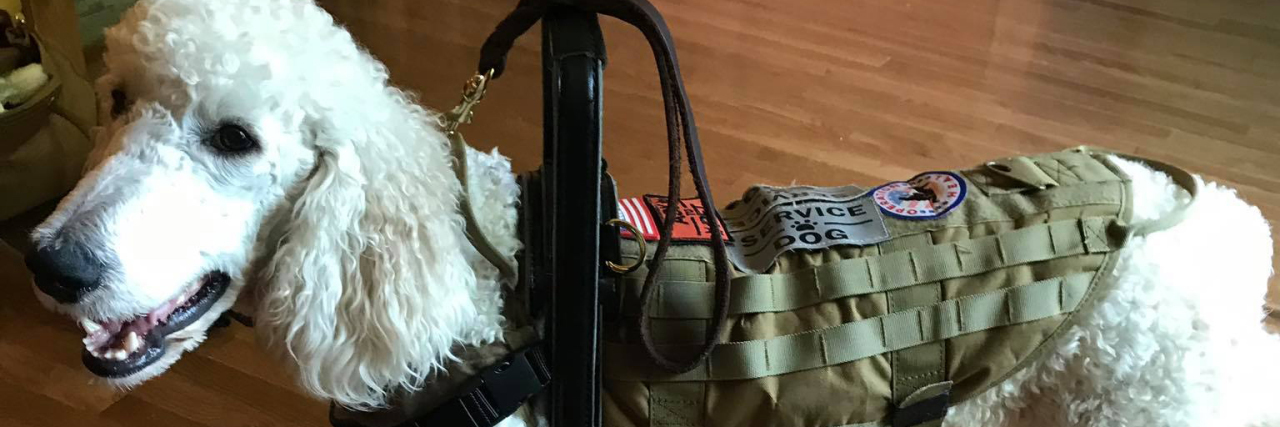Before I talk about the incident that happened at the veterans’ hospital, I want to clarify a few things.
First, let’s define “fake” — “not genuine; counterfeit.” As a noun, “a thing that is not genuine; a forgery or sham.” Therefore, the definition of a “fake” service dog is a dog that the owner or handler chooses to pretend is a genuine service dog. A “real” or genuine service dog, is defined under the ADA as a dog that has been individually trained to do work or perform tasks for an individual with a disability. The task(s) performed by the dog must be directly related to the person’s disability. Key words in this definition include “dog,” “work or task” and “disability.” A service dog is not required to wear a vest, ID tag or specific harness.
So how can anyone know if a service dog is fake? You can’t identify them by looks or by requesting documentation of any kind. In situations where it is not obvious that the dog is a service animal, staff may legally ask only two specific questions: (1) is the dog a service animal required because of a disability? and (2) what work or task has the dog been trained to do?
The ADA states the following regarding service dog behavior:
1. Service animals must be under the control of the handler at all times.
2. The service animal must be harnessed, leashed or tethered while in public places unless these devices interfere with the service animal’s work or the person’s disability prevents use of these devices. In that case, the person must use voice, signal or other effective means to maintain control of the animal.
3. Under control also means a service animal should not be allowed to bark repeatedly in a lecture hall, theater, library, or other quiet place. However, if a dog barks just once, or barks because someone has provoked it, this would not mean the dog is out of control.
4. If a service animal is out of control and the handler does not take effective action to control it, staff may request that the animal be removed from the premises.
Service dog training may be completed by yourself, a friend, family member, professional trainer or training organization. It usually takes at least six months to properly train a service dog, although a full-time professional trainer may be able to train a dog more quickly. I spent at least 30 hours in a controlled public setting so my dog Toad would learn to behave obediently and inconspicuously in public.
Toad and I had a situation with what I believe was a fake service dog while at Kansas City VA. A dog growled, barked and lunged at Toad. I spoke to the owners and told them their dog should be removed. After that I decided I’d to take a more active role in addressing situations like that.
Because of the training Toad has had and continues to have, I assume dogs that behave aggressively or out of control have to be fake. It then frustrates me when the handler will state their dog is a service animal. It may be wrong for me to assume the dog is a fake because of its behavior, but so far in my experience they have been.
The second incident with an untrained or fake service dog happened this past Wednesday. Toad and I were walking into the VA hospital for appointments when I noticed two dogs on the right side of the walkway. I knew I had heard a dog barking but did not know where the dog was. Neither of them had any gear, patch or harness on. Only one had a leash.
As soon as the leashed dog saw Toad, he lunged in our direction and began barking. Thankfully Toad was on my left side — one of his jobs is mobility, counterbalancing and my left is my weakest side. The aggressive dog was on my right. Toad stayed focused with few glances at the dog, however, the dog was not under control and came very close to me while barking. I was scared and made a decision at that moment. I would file a report with VA police.
As soon as I walked in, got the attention of a staff member and asked for the VA police. What I did not know was the dog had been aggressive towards two people just outside and VA police were already on their way.
A couple of people started talking about the ADA; instead of engaging only in conversations or arguments I handed them a couple of ADA law cards I carry with me. This made it easier to focus on the facts of the law. During my conversation with the police I was told the handler insisted her dog was a service dog. I felt I needed to clarify and stress to the people next to me and the staff that due to the dog’s behavior it should be removed, whether it was a real service dog or not. The VA police took my statement and reassured me they “want to keep people and service dogs safe, the only way to do that is if people report or call them when a situation like this happens.”
The negative effects of these individuals can be far reaching. “Under the law, people have rights. Dogs do not. A service dog without its disabled partner is just a dog.”
It is important to remember thatpeople who impersonate a disabled person or claim their pet is a service dog so they can take it where pets are not allowed are breaking federal law. Police can and should be called on such an individual. Those of us who are disabled and have legitimate service dogs or service dogs in training need to work together with the community and law enforcement to help combat what’s happening.

